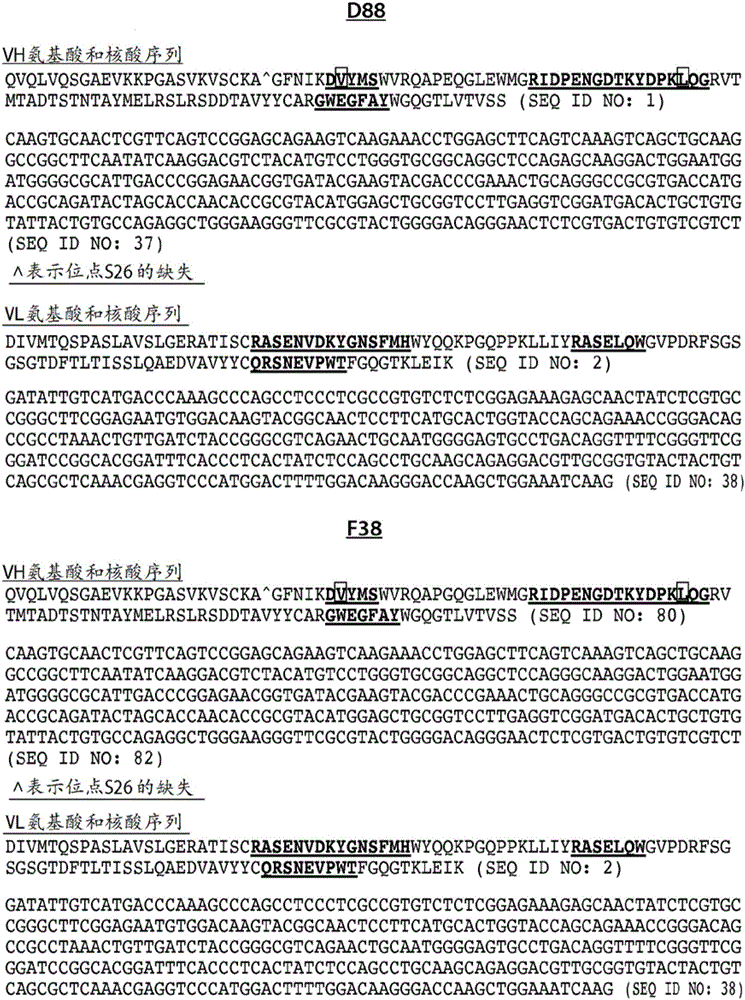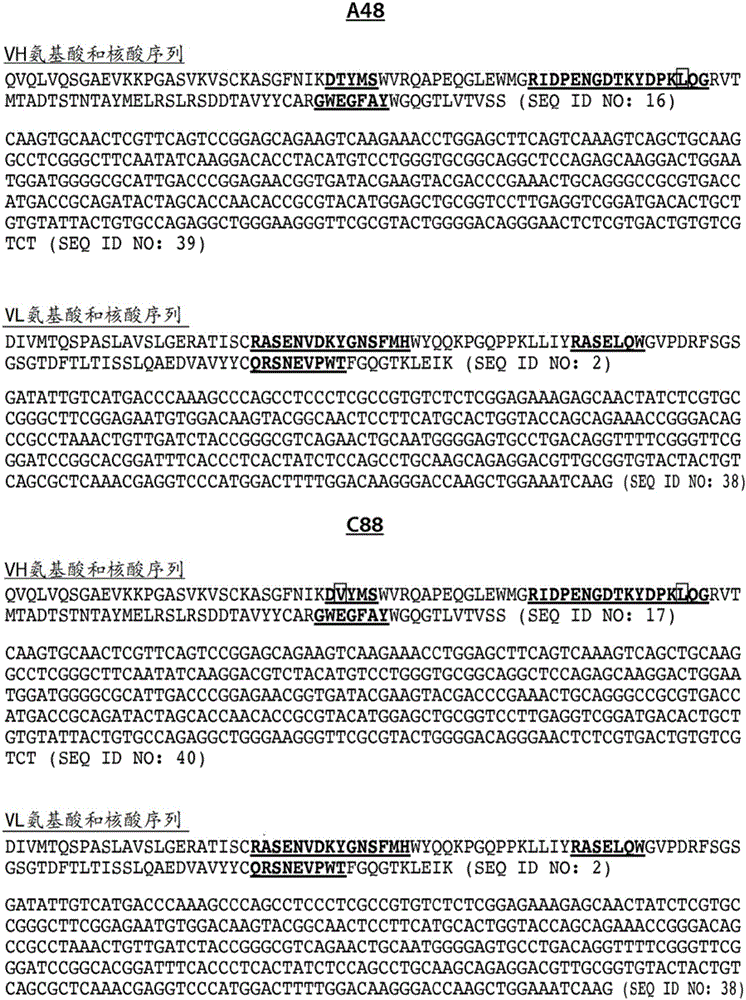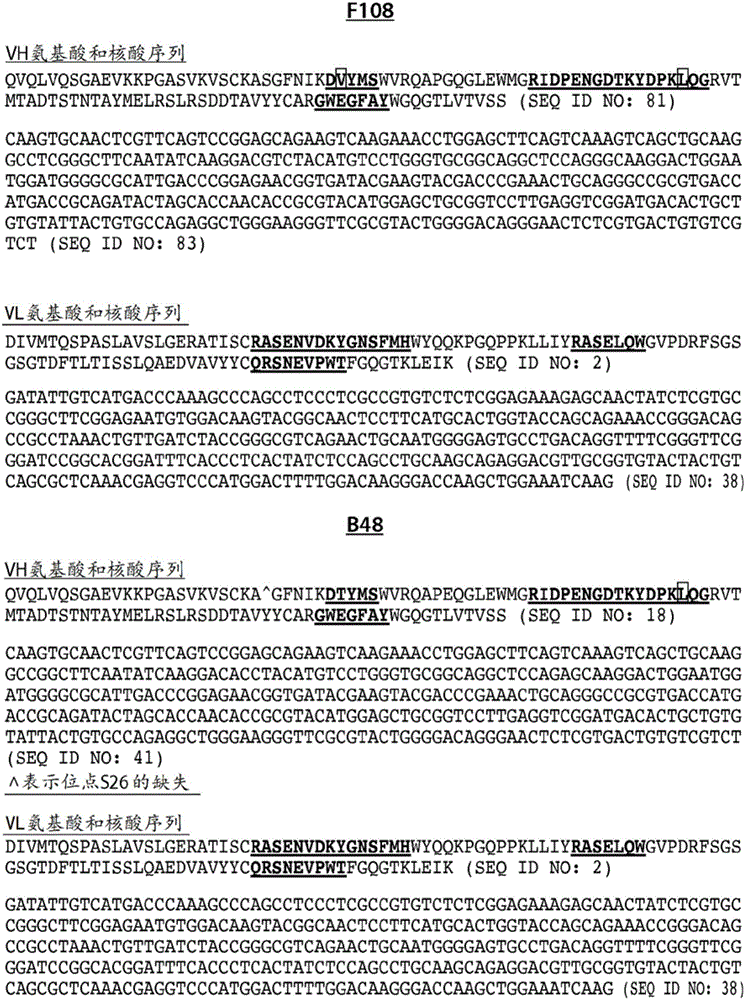Antibody moleules to dengue virus and uses thereof
A technology of antibody molecule and dengue virus, which is applied in the field of antibody molecule for dengue virus and its application, can solve the problems of antigenic difference and hindering the effective treatment of serotype
- Summary
- Abstract
- Description
- Claims
- Application Information
AI Technical Summary
Problems solved by technology
Method used
Image
Examples
Embodiment 5
[0251] Example 5 also shows that position 98 in the VH is mutation resistant and that in some embodiments mutations to position 98 enhance binding. Thus, in some embodiments, position 98 has a mutation relative to the antibodies of Table 1.
[0252] In some embodiments, the anti-dengue antibody molecule comprises a heavy chain constant region, a light chain constant region, and the heavy and light chain variable regions of Table 2. In certain embodiments, the anti-dengue antibody molecule comprises a heavy chain constant region, a light chain constant region, and a variable region comprising the CDRs in 1, 2, 3, 4, 5 or 6 of Table 3.
[0253] In some embodiments, the heavy chain variable region is a heavy chain variable region of Table 1, wherein residue 98 in VH can be any amino acid. In certain embodiments, residue 98 may be any uncharged amino acid. In some embodiments, position 98 may be A, V, or S. Example 5 below shows that antibodies with A, V or S at position 98 hav...
Embodiment 1
[0357] Example 1: Structure-Guided Design of Anti-Dengue Antibodies
[0358] Epitope and template identification
[0359] There are multiple neutralizing epitopes within the dengue virus E protein dimer. These epitopes include, for example, regions in EDI, EDII, EDIII, the fusion loop, the EDI / II hinge, and the EDIII "A" beta-strand. EDI and EDII are immunodominant in humans and are able to induce weakly neutralizing but highly cross-reactive antibodies. EDIII is capable of inducing potent neutralizing antibodies. Antibodies against the fusion loop, located in EDII, often show cross-serotype reactivity but not strong neutralizing activity. Antibodies against the EDI / II hinge region can exhibit potent neutralization, but are often serotype-specific due to poor conservation of the epitope region. Antibodies against the EDIII A-chain are generally due in part to the higher accessibility of this region to the antibody, but generally have limited cross-serotype reactivity.
...
Embodiment 2
[0368] Example 2: De126 improves DV-4 neutralization activity
[0369] B11 is an anti-dengue antibody that has a heavy chain deletion at S26 in framework 1 (FR1 ) compared to A11 (4E5A). 4G2 is a control anti-dengue antibody. The neutralizing activity of each antibody against EDIII from the four dengue virus serotypes was tested by the focused reduction neutralization test (FRNT).
[0370] When dengue virus infection host is vero cells (Vero) cells, the focused reduction neutralization assay detects the formed lesions. Briefly, dilutions of antibody were mixed with an equal volume of diluted virus, and the mixture was transferred to Vero cell monolayers, and lesions were detected. Data are presented as relative infectivity. FRNT 50 Represents the antibody concentration required to achieve 50% virus neutralization. A more detailed protocol for the focal reduction neutralization assay can be found in Tharakaraman et al., 2013, Proc Natl Acad Sci US A. 2013; 110(17):E1555-...
PUM
 Login to View More
Login to View More Abstract
Description
Claims
Application Information
 Login to View More
Login to View More - R&D
- Intellectual Property
- Life Sciences
- Materials
- Tech Scout
- Unparalleled Data Quality
- Higher Quality Content
- 60% Fewer Hallucinations
Browse by: Latest US Patents, China's latest patents, Technical Efficacy Thesaurus, Application Domain, Technology Topic, Popular Technical Reports.
© 2025 PatSnap. All rights reserved.Legal|Privacy policy|Modern Slavery Act Transparency Statement|Sitemap|About US| Contact US: help@patsnap.com



